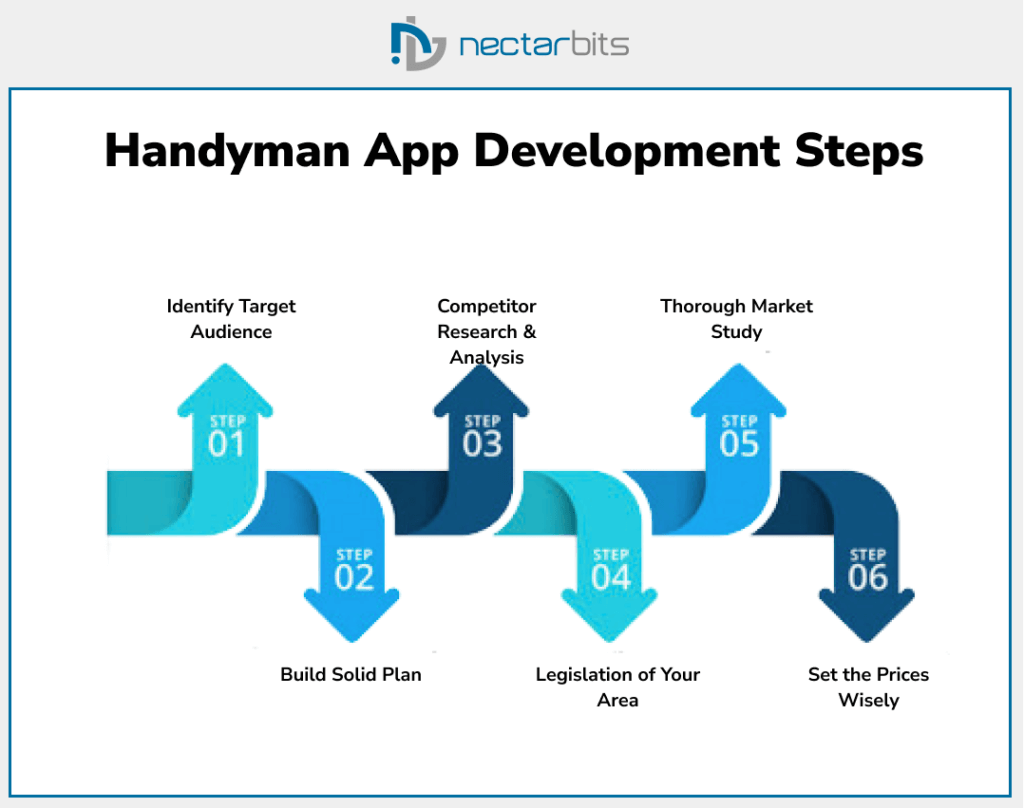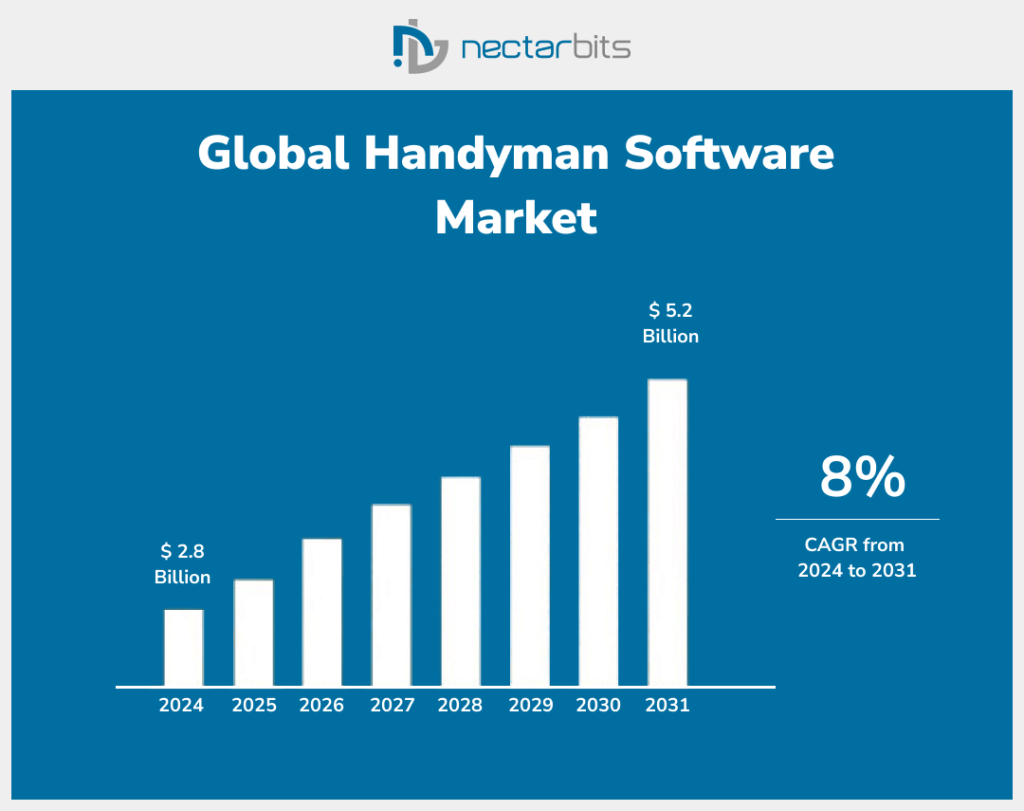As the world demands more accessible products and services through advancements in the on-demand app industry, one of the frontrunners of this rapidly growing trend has been observed within on-demand home services. Handyman service apps are rapidly growing to capture this lucrative market gap, offering a wide range of repair and maintenance tasks for your house at competitive prices. With the market saturated with handyman apps, standing out from this sea to develop a successful handyman app is crucial for success.
This guide explores the secret sauce behind developing a handyman app for your target market. We will understand the critical features that entice people to use your services. We will also discuss the applicable on-demand handyman app development costs and provide a comprehensive breakdown of how to develop a successful app in this rapidly growing and crowded global market.
Why are Handyman Apps Popular?
Before exploring the various features of a handyman app, it is essential to note what makes these apps so popular. One of the primary reasons behind their popularity is their ability to provide a quick, reliable and efficient home repair service that gained traction during and after the pandemic. With people adopting a more work-from-home ethic, a well-designed handyman app can bridge the gap between service providers and homeowners, offering better communication and more rapid service deliveries.
Read More:- Top-Rated On-Demand Handyman Apps to Enhance Your Home Services in 2024
Key Features of a Handyman Services App
The reason behind the success of any modern handyman app business model relies heavily on its feature set and how it stands out from its competitors. With the right mix of handyman app features, a user can gain a more streamlined service ordering experience with a clear fee structure and an effortless payment experience. Below are some of the most important key features of the handyman services app development that can guarantee your company’s success in this growing market:-
1. User-Friendly Interface
No program is better than its user interface. In terms of functionality, customers must be able to move within the app, search for services, and book them without wanting to pull their hair out. A cluttered or confusing design can reduce overall clicks and impressions and increase bounce rates, which could be better for business. The primary UI&UX design should offer convenient ways of choosing the service and making payments to be effective.
2. Service Listings and Categorization
An efficient handyman app must provide comprehensive service offerings with well-defined subcategories. This means that handyman app features should enable users to search for services relevant to their needs, such as plumbing, electrical, or carpentry. Correct subject categorization prevents users from experiencing irritation by helping customers find what they want.
3. Real-Time Job Tracking
The key selling points of on-demand home services are real-time job tracking, real-time updates, and on-demand updates. This feature lets users track the handyman’s location, estimated arrival time, and job progress. Such transparency fosters trust and keeps the users interested throughout the service cycle.
4. Secure Payment Gateway
The payment gateway must be safe and multiple to improve the portal’s efficiency. Above all, the app should allow the use of several modes of payment, including credit/debit cards, mobile money, and cash on delivery. In addition to protecting user data, the payment system should enhance customer satisfaction.
5. Booking Flexibility
Another feature that affects the choice of a handyman application is the ability to choose a convenient time for a booking. Customers should get the opportunity to book services according to their preferred schedule. Whether the booking is for the current day or months forward, the app has to provide an option where the user can book at the time and date of his/her convenience.
6. Service Provider Profiles and Reviews
Transparency is a critical aspect of on-demand handyman app development services that must be considered when selecting service providers. Every handyman working for the platform should provide information about their experience, specialization, and previous clients’ feedback. This feature assists the users in making appropriate choices, thus enhancing customer satisfaction and, consequently, the quality of service delivery.

Advanced Features to Enhance User Engagement
A good handyman app should incorporate additional secondary features in addition to the basic functionalities to stand out from its competitors.
1. Push Notifications
Push notifications are an effective method of maintaining an active user base. They can inform customers of the schedules of the next booking, special offers or new products and services. This is particularly useful for user engagement and encouraging people to come back to your site or app for more: with push notifications, users feel like you’re reaching out to them directly and are, therefore, much more likely to take the time to respond to an offer of an update.
2. In-App Chat Support
Users and service providers must be able to communicate effectively. This feature means that there is an in-app chat option that permits real-time interaction and questions in case of complicated instructions. It can also be useful for resolving conflict and guaranteeing a seamless service-oriented experience.
3. Loyalty Programs and Discounts
Customer acquisition is important, but maintaining customers is even more important because they are the ones who will make your business thrive in the long run. Features like discounts, referral payments, or bonuses will make customers prefer your app over others. An additional advantage of loyalty programs is that they can influence users to arrange services more often, thereby increasing sales.
4. GPS Integration
The use of GPS in your app is essential for effective navigation and location tracking. It ensures that the handyman is directed towards the customer’s location, and the customer can, in turn, follow the service provider’s movement.
5. Ratings and Reviews
As with any service, it will be useful for other users to see how satisfied others have been and to leave their own opinions on the service as well. This will assist in enhancing the quality of service offered to your clients and add credence to your platform.
Statistical Overview of the Handyman App Market
To better understand the demand for handyman services apps and why companies are trying to capitalize on this market with advanced handyman app features and development, here’s a snapshot of the market potential:

The graph above showcases a considerable year-on-year market growth and how the handyman app market is projected to surpass the cumulative revenue of $5.2 Billion by the end of 2031.
Understanding the Handyman App Business Model
With the functionality of the Handyman app in mind, let’s proceed to discuss its business model. The most common business models include:
- Commission-based: The app takes a percentage of the amount in the transaction between the user and the handyman.
- Subscription-based: The service providers subscribe to the platform by paying monthly or on a per-subscription basis to be listed on the platform.
- Lead generation: The app offers selling users’ requests or inquiries to service providers as leads.
All the business models mentioned have advantages and disadvantages. Still, to make the right decision, we must consider the characteristics of our target audience, the market and most importantly, the cost of development that needs to be recuperated from the business model.
On-Demand Handyman App Development Cost
The on-demand handyman app development cost can vary significantly based on variable factors such as features and the geographical location of the development team on hire. Platform support (iOS, Android, or both) and inflation can also play a great role in the variability factor of such development costs. Here is a breakdown of the average development costs you can expect, analyzed by averaging development costs for handyman apps divided by their components over the last decade:-
| App Component | Cost Estimate (USD) |
|---|---|
| Basic Features (UI, payment, etc.) | $15,000 – $25,000 |
| Add-On Features (real-time tracking, chat) | $10,000 – $15,000 |
| Admin Dashboard and Analytics | $8,000 – $12,000 |
| App Maintenance and Support | $2,000 – $5,000 per year |
By analyzing the table above, you can deduce that the average complete development cost of a handyman app today can range between $33,000 and $52,000. While this may seem high to an emerging startup or entrepreneur, it is vital to invest in high-quality, on-demand handyman app development services to ensure smooth operation, great customer service, and regular updates for better business sustainability.
Read More:- Best Ways for Startups to Reduce App Development Cost in 2024 – 2025
How to Choose the Right On-Demand Handyman App Development Services
Finding the appropriate people to create your app idea is critical to the success of a mobile application development project. Here are some tips:
- Experience in On-Demand App Development: Select a company that has experience having successfully implemented the on-demand home services features concept.
- Post-Launch Support: Ensure the team provides constant support and additional information after release.
- Cost Transparency: Get a cost estimate for developing an on-demand handyman app and ensure that there are no hidden costs.

Conclusion: Building a Successful Handyman App
Building a handyman app is not only about developing the application but also about multiple strategies. This involves understanding the user’s needs, identifying the necessary and optional but convenient features for the app, and devising the right handyman app business model to adapt. The success of companies able to offer humble and smooth services to users and pure transparency and engagement can pave their way in this already saturated market.
Make sure to include all of the aspects of budgetary planning when defining the expenditure process for your on-demand handyman app development cost in a bid to get high returns on your investment. When it comes to handyman app development, you should seek help from the appropriate on-demand solution that can help you build a feature-packed application that will meet the expectations of consumers and that will be different from most of the similar apps on the market. There’s no better time than now to take advantage of this and penetrate the growing market of handyman services.
Frequently Asked Questions (FAQs)
A successful handyman app includes a user-friendly interface, service listings with categorization, real-time job tracking, secure payment gateways, and booking flexibility.
1: The app must also have: Service provider profiles with reviews
2 : Advanced features like GPS integration
3 : Push notifications for updates
4 : In-app chat support for seamless communication
The cost to develop a handyman app depends on the features and geographical location of the development team. On average, the cost can range from $33,000 to $52,000.
Breakdown of costs:
Basic features: $15,000 – $25,000
Add-on features: $10,000 – $15,000
Admin dashboard: $8,000 – $12,000
Maintenance: $2,000 – $5,000 per year
A successful handyman app business model offers value through commission-based, subscription-based, or lead-generation models, depending on your target audience and market demands.
Factors to consider: Audience needs and preferences
1: App development costs
2 : Transparent pricing and post-launch support
Handyman apps are gaining popularity due to their convenience and efficiency. Users can book reliable home services quickly, enhancing their experience post-pandemic.
Key reasons: Work-from-home trends
Faster service communication
Real-time updates and tracking
Ease of payment through mobile apps
To stand out, a handyman app must offer advanced features such as push notifications, in-app chat support, loyalty programs, and GPS integration.
Benefits of these features:
Enhanced user engagement
Better customer retention through loyalty rewards
Real-time navigation and service tracking for convenience









